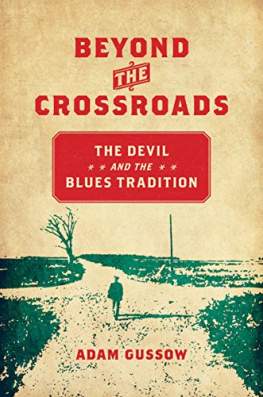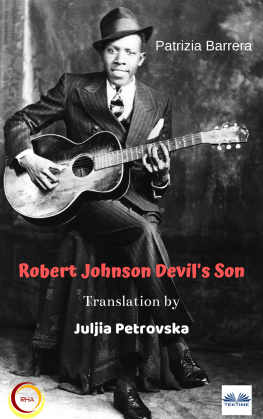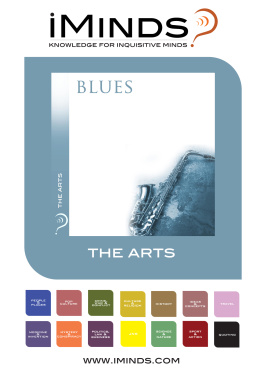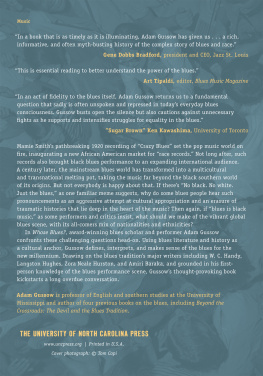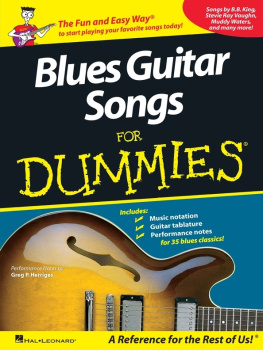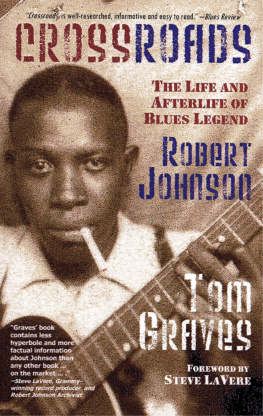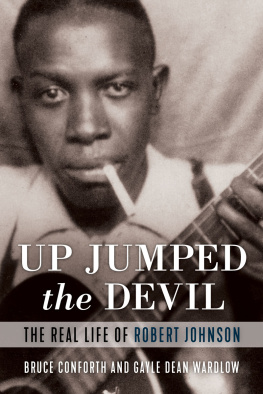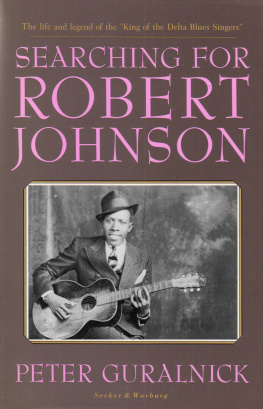Gussow Adam - Beyond the crossroads: the devil et the blues tradition
Here you can read online Gussow Adam - Beyond the crossroads: the devil et the blues tradition full text of the book (entire story) in english for free. Download pdf and epub, get meaning, cover and reviews about this ebook. City: USA, year: 2017, publisher: UNC Press Books, genre: Home and family. Description of the work, (preface) as well as reviews are available. Best literature library LitArk.com created for fans of good reading and offers a wide selection of genres:
Romance novel
Science fiction
Adventure
Detective
Science
History
Home and family
Prose
Art
Politics
Computer
Non-fiction
Religion
Business
Children
Humor
Choose a favorite category and find really read worthwhile books. Enjoy immersion in the world of imagination, feel the emotions of the characters or learn something new for yourself, make an fascinating discovery.
- Book:Beyond the crossroads: the devil et the blues tradition
- Author:
- Publisher:UNC Press Books
- Genre:
- Year:2017
- City:USA
- Rating:4 / 5
- Favourites:Add to favourites
- Your mark:
Beyond the crossroads: the devil et the blues tradition: summary, description and annotation
We offer to read an annotation, description, summary or preface (depends on what the author of the book "Beyond the crossroads: the devil et the blues tradition" wrote himself). If you haven't found the necessary information about the book — write in the comments, we will try to find it.
The devil is the most charismatic and important figure in the blues tradition. Hes not just the musics namesake (the devils music), but a shadowy presence who haunts an imagined Mississippi crossroads where, it is claimed, Delta bluesman Robert Johnson traded away his soul in exchange for extraordinary prowess on the guitar. Yet, as scholar and musician Adam Gussow argues, there is much more to the story of the devil and the blues than these cliched understandings.
In this groundbreaking study, Gussow takes the full measure of the devils presence. Working from original transcriptions of more than 125 recordings released during the past ninety years, Gussow explores the varied uses to which black southern blues people have put this trouble-sowing, love-wrecking, but also empowering figure. The book culminates with a bold reinterpretation of Johnsons music and a provocative investigation of the way in which the citizens of Clarksdale, Mississippi, managed to rebrand a commercial hub as the crossroads in 1999, claiming Johnson and the devil as their own.
**
ReviewGussow asks. . .of all the many kinds of African American popular music, why is/was it that blues alone has been singled out as the devils music. . .?-- American Music
Gussows scope is broad and deep, impeccably researched and far too complex and thorough for a brief review to do it justice. . . . His central thesis. . . [challenges] much of the mythologizing of blues culture that has arisen over the years--and, by implication, the patronizing (at best) or downright racist (at worst) assumptions that have often accompanied it. . . . Gussows analysis is prescient, and it adds significantly to our understanding of the texture and complexity of the bluesmens art, its legacy and its meaning.-- Living Blues
Gives blues fans plenty to ponder in this challenging book that doesnt back away from taking on some cherished parts of the blues tradition. Readers will be compelled to revisit some classic tunes to hear the songs with fresh ears, ready to garner new meanings based on the many forms of the devil illuminated in this work. Thanks to Mr. Gussow for attempting to get us out of our blues comfort zones, and for providing readers with well-researched concepts that invite us to do more than just listen to the music.-- Blues Blast
A model work of scholarship: years of meticulous and extensive archival work are the foundation for this multidisciplinary study that carefully and respectfully applies research in cultural history, anthropology, psychology, popular culture, film studies, and more to the use of the devil figure and related imagery within the blues tradition.-- Journal of Southern History
Masterfully researched, impeccably well-written, spell bindingly interesting food for thought for curious minds. . . . An important addition to any serious blues readers bookshelf.-- The Country Blues
By looking at over 125 blues songs, Gussow illustrates that the devil stands at the center of the black Southern blues tradition as a figure that sows trouble, wrecks love, but also gives power.-- No Depression
An excellent antidote to the mystification of the music.-- Choice
Review
Beyond the Crossroads is brilliant, a game-changer in blues history. A breathtaking and highly engaging book on a most American of sounds.--Patricia Schroeder, author of Robert Johnson, Mythmaking, and Contemporary American Culture
Adam Gussow is an excellent interpreter of the blues.He has earned the right to speak.We should listen to him and be informed about one of the most important musical expressions in American history. I strongly recommend Beyond the Crossroads: The Devil and the Blues Tradition.--James H. Cone, author of The Spirituals and the Blues
At once affable and frightening, the devil is forever partnered with the blues. Beyond the Crossroads is a beautifully written exploration of what Adam Gussow calls the blues most malleable, dynamic, and important personage. This is a work of exquisite detail.--William Ferris, author of Give My Poor Heart Ease: Voices of the Mississippi Blues
Gussow Adam: author's other books
Who wrote Beyond the crossroads: the devil et the blues tradition? Find out the surname, the name of the author of the book and a list of all author's works by series.

